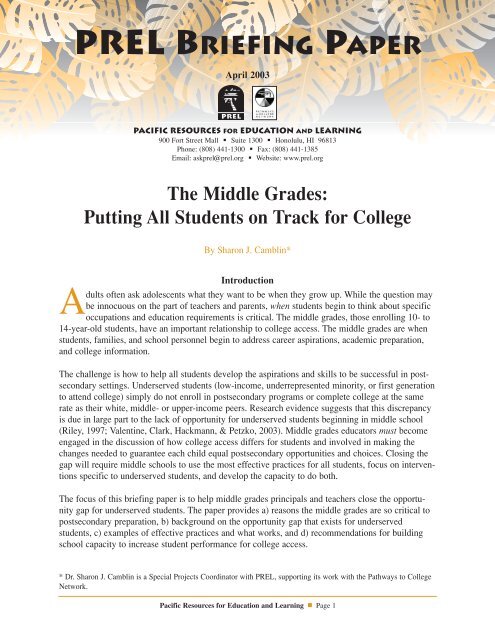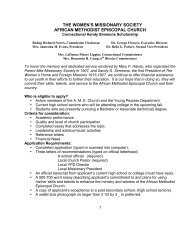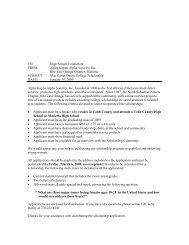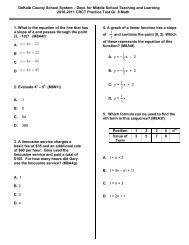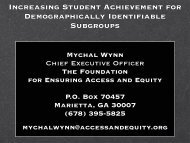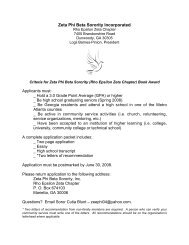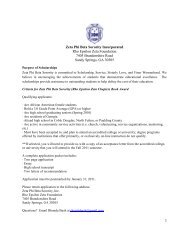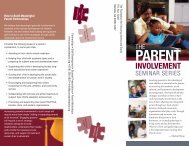Middle Grades.Putting All Students on Track for College - Ensuring ...
Middle Grades.Putting All Students on Track for College - Ensuring ...
Middle Grades.Putting All Students on Track for College - Ensuring ...
- No tags were found...
Create successful ePaper yourself
Turn your PDF publications into a flip-book with our unique Google optimized e-Paper software.
A Critical Relati<strong>on</strong>shipThe middle grades have a critical impact <strong>on</strong> the postsec<strong>on</strong>dary success of students because it is herethat two factors collide. The middle grades are the intersecti<strong>on</strong> of students’ needs to “get <strong>on</strong> track”<strong>for</strong> college and to determine what they will be like as adults. For white, middle- and upper-incomestudents, this collisi<strong>on</strong> most often results in a sudden focus <strong>on</strong> college opportunities. For underservedstudents, the collisi<strong>on</strong> is more challenging. The decisi<strong>on</strong>s made during this time have lifel<strong>on</strong>g c<strong>on</strong>sequencesabout how these students see themselves as learners, engage with learning, and set theirgoals.The choice to go to college is a three-stage developmental process that includes predispositi<strong>on</strong>,searching, and choosing. These stages begin as early as the 7th grade. According to Cabrera, LaNasa, and Burkum (2001), most 9th graders have already developed both occupati<strong>on</strong>al and educati<strong>on</strong>alaspirati<strong>on</strong>s. Each stage has particular cognitive and affective outcomes that cumulativelyprepare students to make certain decisi<strong>on</strong>s regarding their college educati<strong>on</strong>. Each stage interactswith the previous stage in subtle and complex ways.Most closely associated with the middle grades is the predispositi<strong>on</strong> stage, which is when studentsdevelop their occupati<strong>on</strong>al and educati<strong>on</strong>al aspirati<strong>on</strong>s. A challenge <strong>for</strong> parents and school pers<strong>on</strong>nelis to help students see the c<strong>on</strong>necti<strong>on</strong> between thinking they want to go to college and learning howto prepare <strong>for</strong> college entrance. The ages between 10 and 14 are most comm<strong>on</strong>ly when studentsengage or disengage from school and learning. The transiti<strong>on</strong> to middle school has been associatedwith a decline in academic achievement, per<strong>for</strong>mance motivati<strong>on</strong>, and self-percepti<strong>on</strong> (Nati<strong>on</strong>al<str<strong>on</strong>g>Middle</str<strong>on</strong>g> School Associati<strong>on</strong> [NMSA], 2002). The middle grades classroom influences whetherstudents see themselves as smart and worthy of taking challenging courses in high school. As theydevelop an adult self-c<strong>on</strong>cept, self-esteem, and racial identity, students make decisi<strong>on</strong>s about howacademic achievement, certain careers, and college fit into this self-percepti<strong>on</strong>.Research statistics suggest that middle grades students often think about going to college but fail toplan or obtain support <strong>for</strong> the intermediate steps (Cabrera, La Nasa, & Burkum, 2001; Nati<strong>on</strong>alCenter <strong>for</strong> Educati<strong>on</strong> Statistics [NCES], 1994). The tragedy is that the failure at an early age todevelop a plan <strong>for</strong> approaching college has dramatic impact <strong>on</strong> what actually happens to students,especially those c<strong>on</strong>sidered underserved. <str<strong>on</strong>g>Students</str<strong>on</strong>g> who focus <strong>on</strong> going to college during the middlegrades are far more successful at actually attending college despite other challenges (Cabrera, LaNasa, & Burkum, 2001). These students plan their sec<strong>on</strong>dary schooling around appropriate courseselecti<strong>on</strong>s and extracurricular activities. They become interested in maintaining good academic per<strong>for</strong>mance.In additi<strong>on</strong>, their families become involved in securing in<strong>for</strong>mati<strong>on</strong> about ways to financea college educati<strong>on</strong> and most often begin saving <strong>for</strong> the expense.The Opportunity Gap <strong>for</strong> Underserved <str<strong>on</strong>g>Students</str<strong>on</strong>g>Rothman (2001/2002) suggests that there is an opportunity gap <strong>for</strong> underserved students thatexplains their lower college enrollment rates. Through no fault of their own, undeserved students areoften deprived of the opportunity to prepare and plan <strong>for</strong> college. Underserved students are taughtdifferent curricula at different levels of rigor, experience cultural stereotyping, and are underrepresentedin academically rigorous courses (Silver, 2000). Other deprivati<strong>on</strong>s include lower teacherexpectati<strong>on</strong>s, less effective instructi<strong>on</strong>al strategies, less counseling c<strong>on</strong>tact, and fewer collegepreparatory classes.The ir<strong>on</strong>y of the preparati<strong>on</strong> gap is that when underserved students have the necessary academicskills, they can per<strong>for</strong>m admirably in even the most demanding collegiate envir<strong>on</strong>ments. WhenPacific Resources <strong>for</strong> Educati<strong>on</strong> and Learning ■ Page 2
minority students take upper-level math and science classes in high school, <strong>for</strong> instance, they can besuccessful in college despite all other challenges. According to a summary report of educati<strong>on</strong>alequity and re<strong>for</strong>m between 1990 and 2000 (<strong>College</strong> Board, 2000), low-income and minority studentswho master algebra and geometry and have expectati<strong>on</strong>s to go to college actually enroll in college atthe same rate as their n<strong>on</strong>-minority peers with those same academic experiences. They also succeedat about the same rate.Lower Teacher Expectati<strong>on</strong>sThere is a c<strong>on</strong>trast between student and family plans <strong>for</strong> college and teacher perspectives <strong>on</strong> studentachievement. A recent poll c<strong>on</strong>ducted by Harris Interactive (2001) reports that while 71% of studentssay they plan to attend a four-year college, 51% of their parents and <strong>on</strong>ly 32% of their teachersbelieve they will actually go. Even more significant is that just 28% of teachers surveyed see goingto college as a goal <strong>for</strong> students in their own classrooms.Particularly at the middle grades, it is critical to c<strong>on</strong>sider the attitudes students develop toward academicachievement. Whether because of limited professi<strong>on</strong>al training or pers<strong>on</strong>al dispositi<strong>on</strong>, teacherswho lack high expectati<strong>on</strong>s <strong>for</strong> student learning have a dramatic impact <strong>on</strong> underserved students.Based <strong>on</strong> their own beliefs about race, ethnicity, and socioec<strong>on</strong>omic background, educators makejudgments about students’ ability to learn, interest in learning, and chances <strong>for</strong> success in college andbey<strong>on</strong>d. It is important to look at whether students do not succeed because their teachers do notexpect them to, c<strong>on</strong>vincing them not to try hard in school and closing doors to those students’ futures(George & Ar<strong>on</strong>s<strong>on</strong>, 2003; Rothman, 2001/2002).Even when underserved students have high expectati<strong>on</strong>s <strong>for</strong> themselves after high school, they candevelop a discrepancy between their achievement attitudes and their achievement behaviors. Underservedstudents who hold positive attitudes toward academic achievement, but who are not supportedby the school structures or teachers, often develop what <strong>on</strong>ly seem to be poor attitudes (Ford, 1995).The result? An inc<strong>on</strong>sistency between a student wanting to be academically successful and actuallyputting <strong>for</strong>th the ef<strong>for</strong>t to be successful.Less Effective Instructi<strong>on</strong>al StrategiesThe lack of opportunity <strong>for</strong> underserved students to become ready <strong>for</strong> college is linked to howschools group students and provide instructi<strong>on</strong>. The practices of academic tracking or ability groupingshow devastating effects <strong>on</strong> underserved students. Assignment to different tracks affects the waystudents view themselves and influences the amount of ef<strong>for</strong>t they put into their schoolwork, the waythey behave in class, and the extent of their achievement (Hoffer, 1993; Oakes, 1995; Tucker &Codding, 1998). Underserved students are overrepresented in lower tracks.The tragedy of tracking is that less-experienced teachers who have fewer resources frequently teachlower-track classes. The instructi<strong>on</strong>al strategies are less research-based and less effective in achievingacademic excellence. In the area of reading at the middle grades, <strong>for</strong> example, research indicatesthat the amount of instructi<strong>on</strong>al time spent <strong>on</strong> teaching students how effective readers make meaningof texts has a significant impact <strong>on</strong> student achievement. Teachers in high-poverty schools spend39% of their time <strong>on</strong> reading skills, compared to 55% in more affluent schools (NCES, 1994).Higher-track classes use different kinds of instructi<strong>on</strong> with more emphasis <strong>on</strong> inquiry methods, problemsolving, and small group work. Instructi<strong>on</strong> tends to engage students more directly in theirlearning and includes working in groups. The lower-track classes are dominated by instructi<strong>on</strong>alstrategies that are passive; students do lots of worksheets and tend to work al<strong>on</strong>e (Hoffer, 1993;O’Neil, 1992; Valentine, Clark, Hackmann, & Petzko, 2003).Pacific Resources <strong>for</strong> Educati<strong>on</strong> and Learning ■ Page 3
Less Counseling C<strong>on</strong>tactAdding to the lack of opportunities <strong>for</strong> students is the lack of academic counseling that wouldprovide in<strong>for</strong>mati<strong>on</strong> about college preparati<strong>on</strong> coursework. Low-per<strong>for</strong>ming students who needassistance in developing educati<strong>on</strong>al goals are the least likely to have received such help. Highper<strong>for</strong>mingstudents are much more likely to report that they talked with counselors several timesabout which classes to take when they reach high school. These students are also much more likelyto report that they intend to complete college (Co<strong>on</strong>ey, 2000).Fewer <strong>College</strong> Preparatory ClassesThe underserved student has greater transiti<strong>on</strong> issues into high school and enrolls in fewer collegetrackcourses. In a five-year study of urban middle schools, Balfanz and MacIver (2000) found thatpoor educati<strong>on</strong>al experiences in many of these schools c<strong>on</strong>tribute to the inability of nearly half ofthese students to make a successful transiti<strong>on</strong> into high school. And though the research is clear thathigh school students who take algebra, geometry, and other rigorous mathematics courses are morelikely to go <strong>on</strong> to college, low-income and minority students are far less likely to be enrolled in suchcourses than other students (Berkner & Chavez, 1997; Riley, 1997). In additi<strong>on</strong>, although 71% of thestudents who take geometry go <strong>on</strong> to college (compared to 25% who do not take geometry), <strong>on</strong>ly46% of low-income students take a geometry course (Riley, 1997). The end result is that underservedstudents take fewer steps in high school to prepare <strong>for</strong> college and enroll in college at much lowerlevels.Effective Practices – What Works<str<strong>on</strong>g>All</str<strong>on</strong>g> middle grades educators face the challenge of changing what they teach, when they teach it, andhow they teach it in order to increase student achievement (Co<strong>on</strong>ey, 2000). The good news is thatmiddle schools have already identified many of the practices and strategies that can benefit allstudents, including linguistically or culturally different and first generati<strong>on</strong> college-going students.Support <strong>for</strong> <str<strong>on</strong>g>All</str<strong>on</strong>g> <str<strong>on</strong>g>Students</str<strong>on</strong>g>Several nati<strong>on</strong>al groups have taken <strong>on</strong> the task of developing standards <strong>for</strong> and descripti<strong>on</strong>s ofmiddle grades practices that meet the needs of the early adolescent. The Nati<strong>on</strong>al Forum to Accelerate<str<strong>on</strong>g>Middle</str<strong>on</strong>g>-<str<strong>on</strong>g>Grades</str<strong>on</strong>g> Re<strong>for</strong>m (1997), <strong>for</strong> example, proposes that comp<strong>on</strong>ents of effective middleschools include academic excellence, developmental resp<strong>on</strong>siveness, and social equity. Such highper<strong>for</strong>mingschools are focused <strong>on</strong> keeping all students’ future opti<strong>on</strong>s open. Teachers are expectedto work to educate every child well and to overcome systematic variati<strong>on</strong> in resources and outcomesrelated to race, class, gender, and ability.Similarly, the NMSA (1995) and others (Valentine, Clark, Hackmann, & Petzko, 2003) have identifieda number of characteristics of exemplary middle schools such as interdisciplinary teaching,small group advisory programs, and varied instructi<strong>on</strong>al techniques focused <strong>on</strong> active engagement,exploratory programs, and transiti<strong>on</strong> programs. Exemplary practices c<strong>on</strong>verge <strong>on</strong> developing andkeeping a positive school culture, assigning adult advocates <strong>for</strong> every student, building family andcommunity partnerships, setting high expectati<strong>on</strong>s <strong>for</strong> all, and creating and maintaining a sharedvisi<strong>on</strong> with educators committed to and knowledgeable about adolescents. <str<strong>on</strong>g>Students</str<strong>on</strong>g> who do makesuccessful transiti<strong>on</strong>s to high school most often stay <strong>for</strong> several years in middle school with a smallteam of teachers who provide learning opportunities centered <strong>on</strong> hands-<strong>on</strong>, life-related enrichmentactivities, integrated instructi<strong>on</strong>, and cooperative learning groups (Mizelle, 1995).<str<strong>on</strong>g>Middle</str<strong>on</strong>g> schools have also begun to develop the capacity to structure the counselor’s time and thestudents’ opportunity to talk with a trained adult who has the skill to help them extend their aspira-Pacific Resources <strong>for</strong> Educati<strong>on</strong> and Learning ■ Page 4
ti<strong>on</strong>s <strong>for</strong> college and develop a plan to achieve that goal. In additi<strong>on</strong> to the <strong>on</strong>e-<strong>on</strong>-<strong>on</strong>e time, schoolsare striving to involve parents by providing timely in<strong>for</strong>mati<strong>on</strong> about careers, college-preparatoryclasses, and expectati<strong>on</strong>s <strong>for</strong> the transiti<strong>on</strong> into high school and bey<strong>on</strong>d. One support <strong>for</strong> the middlegrades counselor is an effective advisory program in which students can develop close, trusting relati<strong>on</strong>shipswith other supportive adults and increase engagement with learning and feelings of positiveself-esteem and bel<strong>on</strong>ging. Effective advisory programs increase student achievement, promotestudent-teacher relati<strong>on</strong>ships, address general self-esteem and c<strong>on</strong>fidence beliefs, link parents withthe school, and mediate between academic and social c<strong>on</strong>cerns (Co<strong>on</strong>ey, 2000; NMSA, 1995).<str<strong>on</strong>g>All</str<strong>on</strong>g> of the research <strong>on</strong> middle schools points to the need <strong>for</strong> special attenti<strong>on</strong> to the transiti<strong>on</strong> intohigh school. Evidence has shown that transiti<strong>on</strong>al disc<strong>on</strong>tinuity can have a negative impact <strong>on</strong>student academic per<strong>for</strong>mance (Rice, 1997). The attributes of successful transiti<strong>on</strong> programs into andout of the middle school include being sensitive to the anxieties accompanying a move to a newschool setting, acknowledging the importance of parents and teachers as partners in this ef<strong>for</strong>t, andrecognizing that becoming com<strong>for</strong>table in a new school setting is an <strong>on</strong>going process, not a singleevent, and uses different articulati<strong>on</strong> activities. Successful transiti<strong>on</strong> programs provide <strong>on</strong>goingin<strong>for</strong>mati<strong>on</strong> about the new school, new programs, and new expectati<strong>on</strong>s and offer social supportduring the transiti<strong>on</strong> (Mizelle & Irvin, 2000; Nati<strong>on</strong>al Associati<strong>on</strong> of Elementary School Principals[NAESP], 1992).Interventi<strong>on</strong>s <strong>for</strong> the Underserved StudentFirst and <strong>for</strong>emost, teachers need to understand and act <strong>on</strong> the premise that they c<strong>on</strong>trol the teachingpractices and learning experiences that improve student achievement. They need to believe that theycan help students overcome the negative effects of poverty and other c<strong>on</strong>diti<strong>on</strong>s bey<strong>on</strong>d teachers’and students’ c<strong>on</strong>trol (Co<strong>on</strong>ey, 2000). Specific interventi<strong>on</strong>s will be needed to provide the kinds ofpreparati<strong>on</strong> and in<strong>for</strong>mati<strong>on</strong> that will help students become ready <strong>for</strong> college. These interventi<strong>on</strong>sinclude changing instructi<strong>on</strong>al structures and strategies, incorporating linguistic and cultural materialsinto existing curricula, expanding support programs, and helping parents.Changing Instructi<strong>on</strong>al Structures and StrategiesIn high-per<strong>for</strong>ming middle schools that serve underserved students, there are clear standards andhigh expectati<strong>on</strong>s, challenging learning opportunities, and a climate of encouragement. Teachersindicate to students the amount and quality of work needed to earn a high grade. Instructi<strong>on</strong>al time<strong>for</strong> math and reading is increased. Highly qualified teachers use instructi<strong>on</strong>al strategies focused <strong>on</strong>making a difference in student learning, including inquiry-based learning, examples and problemsthat have real-world value, interdisciplinary teaming, and exploratory programs. Small groups andsupportive adults are available to m<strong>on</strong>itor individual student progress and provide extra support tostudents when needed. Perhaps most importantly, students have early positive c<strong>on</strong>tact with counselors,teachers, and the school principal, who provide motivati<strong>on</strong> and encouragement <strong>for</strong> them toattend college (Co<strong>on</strong>ey, 2000; Gay, 1999; George & Ar<strong>on</strong>s<strong>on</strong>, 2003; Krovetz, 1999; Nati<strong>on</strong>al Forumto Accelerate <str<strong>on</strong>g>Middle</str<strong>on</strong>g>-<str<strong>on</strong>g>Grades</str<strong>on</strong>g> Re<strong>for</strong>m, 1997; NMSA, 2002; Robles-Delaney, 2001).Incorporating Linguistic and Cultural Materials Into Existing CurriculaLinguistically and culturally diverse students can achieve academic success when the materials usedin their classrooms directly link their cultural experience to their learning and reflect the local valuesand traditi<strong>on</strong>s in the classroom envir<strong>on</strong>ment. To foster success <strong>for</strong> diverse learners, culturally relevantmaterials need to include <strong>for</strong>mal curriculum materials, in<strong>for</strong>mal classroom materials, andclassroom interacti<strong>on</strong>s (Camblin & Barlow, 2002). Learning is c<strong>on</strong>textualized because it makesc<strong>on</strong>necti<strong>on</strong>s with the home culture, scaffolds the learners’ prior knowledge, and individualizesPacific Resources <strong>for</strong> Educati<strong>on</strong> and Learning ■ Page 5
instructi<strong>on</strong>, which in turn builds <strong>on</strong> the students’ experiences and learning styles. The creati<strong>on</strong> ofcultural capital allows students to feel valued in the school envir<strong>on</strong>ment. The use of culturally relevantmaterials to increase student achievement penetrates the inner core of the teaching and learningprocesses, as well as the lives of students (Gay, 1999).Success with diverse learners requires teachers to have some understanding of culturally determinedreferences <strong>for</strong> thinking and interacting. Social support is based <strong>on</strong> an understanding of culture andrespect, as well as exposing all students to a high-achieving peer group of various races (Garcia,1991; Gay, 1999; Nels<strong>on</strong>-Barber, 1999; Pavel, Reyhner, Avis<strong>on</strong>, Obester, & Sayer, 2002; Pena, 1997;Robles-Delaney, 2001; Trueba & Bartolome, 1997).Expanding Support Programs<str<strong>on</strong>g>Middle</str<strong>on</strong>g> schools need to take a hard look at the inclusi<strong>on</strong> of college outreach and enrichmentprograms during and after the school day. To provide in<strong>for</strong>mati<strong>on</strong>al outreach, career-based outreach,and academic support, middle schools must develop the capacity to build partnerships with communityorganizati<strong>on</strong>s and postsec<strong>on</strong>dary instituti<strong>on</strong>s to intervene <strong>on</strong> behalf of the underserved student.Researchers and practiti<strong>on</strong>ers <strong>for</strong> the most part agree that outreach ef<strong>for</strong>ts that increase students’aspirati<strong>on</strong>s, expose them to the rigors of college at an early age, and provide interventi<strong>on</strong>s aimed atimproving their academic per<strong>for</strong>mance are instrumental in illuminating and overcoming the barriersto equitable opportunity <strong>for</strong> higher educati<strong>on</strong>. Effective programs are represented by 10 principles ofpractice: 1) setting high standards <strong>for</strong> program staff and students, 2) providing pers<strong>on</strong>alized attenti<strong>on</strong>to each student, 3) providing adult role models, 4) facilitating peer support, 5) integrating theprogram with the school, 6) providing strategically timed interventi<strong>on</strong>s, 7) starting early and makingl<strong>on</strong>g-term investments in students, 8) providing students with a bridge between school and society,9) providing scholarship assistance, and 10) designing evaluati<strong>on</strong>s that c<strong>on</strong>tribute to the overallresults of the interventi<strong>on</strong>s (Gullatt & Jan, 2002).Helping Underserved ParentsThere is also a critical need to support parents who are poor, less educated, and less knowledgeableabout how the educati<strong>on</strong> system works so that children can gain access to and be successful in college.Schools that recognize the need to support parents provide opportunities that encourageparticipati<strong>on</strong> in school activities and include parent educati<strong>on</strong> programs. There is a sensitivity am<strong>on</strong>gstaff members to different cultures and a real attempt to bridge cultural understandings, lessening theneed <strong>for</strong> students to negotiate between different cultural c<strong>on</strong>texts. These schools see the family as asupport and make attempts to rein<strong>for</strong>ce educati<strong>on</strong> at home (Cabrera, La Nasa, & Burkum, 2001;Gandara, 2000; Robles-Delaney, 2001).When families and parents are seen by the schools as having cultural capital or the ability toc<strong>on</strong>tribute in a positive way to their children’s educati<strong>on</strong>, students are much more likely to besuccessful. To better understand students’ families, schools need to develop a framework that integratesclass, race, culture, and gender in a more holistic view of various familial experiences(Robles-Delaney, 2001). In this way, students have less need to negotiate between two differentcultural c<strong>on</strong>texts. Viewing the family as a source of support and building <strong>on</strong> their interest in schooland their desire to see their children succeed could make all the difference.Other steps schools need to take include rein<strong>for</strong>cing home literacy experiences and involving parentsin middle school student activities. Additi<strong>on</strong>ally, providing in<strong>for</strong>mati<strong>on</strong> <strong>on</strong> college access, especiallyfinancial in<strong>for</strong>mati<strong>on</strong>, is critical to the support families can offer their children. Cabrera, La Nasa,Pacific Resources <strong>for</strong> Educati<strong>on</strong> and Learning ■ Page 6
and Burkum (2001) c<strong>on</strong>tend that saving <strong>for</strong> college when their children are still in the middle gradesis a key expressi<strong>on</strong> of parental encouragement <strong>for</strong> their children to aspire to college.Building School CapacityIncreased capacity in the middle school has the potential <strong>for</strong> pers<strong>on</strong>alizing instructi<strong>on</strong>, increasingstudent support and student achievement, and eliminating biases in relati<strong>on</strong> to low-income, underrepresentedminority, and first generati<strong>on</strong> college-going students. What increase in capacity do middleschools need to meet this challenge, and how do they build this capacity?Increased Capacity NeededCapacity relates to what is required <strong>for</strong> any particular organizati<strong>on</strong> to achieve its purposes effectively,efficiently, and sustainably (Hilderbrand & Grindle, 1994; Massell, 1998). The traditi<strong>on</strong>aldefiniti<strong>on</strong> of school capacity has been the knowledge and skills held by teachers and staff. Today,school capacity is the wherewithal needed to translate visi<strong>on</strong> and high standards into effectiveinstructi<strong>on</strong> and str<strong>on</strong>g student per<strong>for</strong>mance. It can also be the collective power of the full staff toimprove student achievement (Massell, 1998; Newmann, King, & Youngs, 2001).Capable schools are those that can not <strong>on</strong>ly per<strong>for</strong>m core functi<strong>on</strong>s such as classroom managementor math instructi<strong>on</strong> well but that also can solve problems, define and achieve specific objectives, andunderstand and deal with their own development needs in a broad c<strong>on</strong>text over a l<strong>on</strong>ger period oftime (Cohen & Ball, 1999). School capacity is not a passive state, but part of an active process. Theincreased capacity that middle schools need to develop are the abilities to:• think systemically, creating organizati<strong>on</strong>al knowledge and focus;• reflect <strong>on</strong> their own beliefs so that they can evaluate teaching practices;• see instructi<strong>on</strong> as the interacti<strong>on</strong> am<strong>on</strong>g teachers, students, activities, and educati<strong>on</strong>almaterials; and• be inclusive in the classroom, school, and local community.Building This CapacityEf<strong>for</strong>ts to strengthen capacity have focused <strong>on</strong> “getting the job d<strong>on</strong>e” or implementing new programsrather than <strong>on</strong> building the sustained ability to carry out interventi<strong>on</strong>s or strategies over a l<strong>on</strong>g periodof time. Educators and the public have emphasized what to change rather than how to change.Policymakers and policy analysts have begun to discuss and implement capacity-building strategies.This implies the development of coordinated and interdependent activities and calls attenti<strong>on</strong> to abroad array of acti<strong>on</strong>s and processes required <strong>for</strong> sustained development (Rickett, 2000). Capacitybuildingstrategies are based <strong>on</strong> the systemic theory that within the school and its larger envir<strong>on</strong>mentthere is an interdependence of the school, students, teachers, and parents that creates sustainablechange.Capacity building <strong>for</strong> the purpose of increasing college aspirati<strong>on</strong>s and academic preparedness <strong>for</strong>middle schools is based <strong>on</strong> three acti<strong>on</strong>s: focusing <strong>on</strong> P-16 alignment and program coherence,providing collaborative structures, and supporting professi<strong>on</strong>al development. To increase their capacityto serve all students, middle schools are str<strong>on</strong>gly encouraged to do the following:• Focus <strong>on</strong> program coherence and a P-16 alignment of standards, curriculum materials, assessments,and instructi<strong>on</strong>al strategies. Improved capacity depends <strong>on</strong> affecting the ways in whichteachers and students understand and influence <strong>on</strong>e another and make use of materials (Cohen& Ball, 1999).Pacific Resources <strong>for</strong> Educati<strong>on</strong> and Learning ■ Page 7
• Focus <strong>on</strong> the envir<strong>on</strong>ment <strong>for</strong> the teachers as well as the students. This includes working tocreate high levels of trust across the staff and providing structures <strong>for</strong> collaborati<strong>on</strong> such asteacher teams and comm<strong>on</strong> planning (Trimble, 2003).• Establish an <strong>on</strong>going professi<strong>on</strong>al development program focused <strong>on</strong> high achievement <strong>for</strong>students and a sense of community <strong>for</strong> the entire school. Provide teachers with technical assistanceand coaching in early adolescent and effective middle school practices. Use facilitators tobuild internal capacity and a greater sense of pers<strong>on</strong>al mastery, c<strong>on</strong>fidence, and ownership(Moffett, 2000). The level of professi<strong>on</strong>al development should be greater than 16 hours annually(Co<strong>on</strong>ey, 2000).C<strong>on</strong>clusi<strong>on</strong>Should middle grades educators be c<strong>on</strong>cerned about preparing students <strong>for</strong> postsec<strong>on</strong>dary opportunities?The unequivocal answer is yes! No level of educati<strong>on</strong> is exempt from scrutiny with regard tocollege access nor is any level excluded from addressing the differences in preparati<strong>on</strong> <strong>for</strong> collegebetween low-income, underrepresented minority, and first generati<strong>on</strong> college-going students andtheir white, middle- or upper-income peers.The investigati<strong>on</strong> of the causes of an opportunity gap is nowhere more important than at the middleschool, when students begin to develop college aspirati<strong>on</strong>s. Closing the gap <strong>for</strong> students will depend<strong>on</strong> abilities of the middle schools to adopt effective practices <strong>for</strong> all students, provide specific interventi<strong>on</strong>s<strong>for</strong> underserved students, and build increased school capacity.What would this look like in a school setting? Imagine two middle schools. Both have hardworkingteachers and principals who want their students to be successful. Both schools are actively involvedin re<strong>for</strong>m ef<strong>for</strong>ts. Un<strong>for</strong>tunately, the first school has not yet developed a comm<strong>on</strong> visi<strong>on</strong> <strong>for</strong> meaningfullearning in the middle grades. Expectati<strong>on</strong>s <strong>for</strong> student learning are low, and teachers areunsure of which instructi<strong>on</strong>al strategies make a difference. Only some students are slated <strong>for</strong> orregistered in upper-level classes in high school.In c<strong>on</strong>trast, the sec<strong>on</strong>d school regularly reflects <strong>on</strong> what the staff believes about learning and evaluatesthe instructi<strong>on</strong>al strategies in terms of success <strong>for</strong> all students. High expectati<strong>on</strong>s are held <strong>for</strong> allstudents. Grouping and instructi<strong>on</strong>al practices are based <strong>on</strong> equity and provide challenging c<strong>on</strong>tentand upper-level skills <strong>for</strong> all students. Both academic and social support are given so that studentsdevelop pers<strong>on</strong>al and academic goals and plans.The first school describes many middle schools that are challenged by a lack of capacity to meet theneeds of all students <strong>for</strong> a successful transiti<strong>on</strong> into high school and <strong>on</strong> to college. While the desireto serve students may exist, until these schools develop new capacity, there will c<strong>on</strong>tinue to be anopportunity gap <strong>for</strong> underserved students.The sec<strong>on</strong>d school, described in the chart <strong>on</strong> page 9, develops processes focused <strong>on</strong> what is requiredto achieve its goals effectively, efficiently, and sustainably. Developing the capacity to ensure collegeaccess <strong>for</strong> all students, this school is able to translate a visi<strong>on</strong> of the school and standards <strong>for</strong> studentlearning into effective instructi<strong>on</strong> and high achievement <strong>for</strong> all students. The people who work theredem<strong>on</strong>strate sustained organizati<strong>on</strong>al change and learning, pers<strong>on</strong>alizati<strong>on</strong>, and increased studentsupport. Racial, class, and gender biases are almost n<strong>on</strong>-existent in terms of student achievement. Asthey leave <strong>for</strong> high school, all students are <strong>on</strong> the college track.Pacific Resources <strong>for</strong> Educati<strong>on</strong> and Learning ■ Page 8
The <str<strong>on</strong>g>Middle</str<strong>on</strong>g> SchoolStudent experiencesSchool practices and strategies <strong>for</strong>all studentsInterventi<strong>on</strong>s <strong>for</strong> the underservedstudentIncreased school capacity<str<strong>on</strong>g>Putting</str<strong>on</strong>g> <str<strong>on</strong>g>All</str<strong>on</strong>g> <str<strong>on</strong>g>Students</str<strong>on</strong>g> <strong>on</strong> <strong>Track</strong> <strong>for</strong> <strong>College</strong>Focus <strong>on</strong> the needs of early adolescentsHold high expectati<strong>on</strong>s <strong>for</strong> all studentsProvide challenging coursework and curriculum <strong>for</strong> allstudentsUtilize small teams of teachersPractice interdisciplinary teachingRecommend academic counselors and advisory programsVary instructi<strong>on</strong>al techniques: hands-<strong>on</strong>, life-related,enrichment activities, integrated instructi<strong>on</strong>, and cooperativelearningEmphasize all instructi<strong>on</strong>al strategies, especially smallgroups and supportive adultsUse linguistic and cultural materials that link the homeand schoolExpand support programsProvide help <strong>for</strong> parentsThink systemically, creating school-wide knowledge andfocusReflect <strong>on</strong> beliefs and evaluate teaching practicesSee learning as the interacti<strong>on</strong> am<strong>on</strong>g teachers, students,activities, and educati<strong>on</strong>al materialsBe inclusive of all students and families – in the classroomand in the schoolThe author would like to thank the following people <strong>for</strong> their assistance with this paper. C<strong>on</strong>cept development reviewers:Dr. Michael Pavel (Eastern Washingt<strong>on</strong> University), Dr. Gilberto C<strong>on</strong>chas (Harvard University), and members of theNASSP <str<strong>on</strong>g>Middle</str<strong>on</strong>g> School Task Force. Draft paper reviewers: Ms. Rosa Ar<strong>on</strong>s<strong>on</strong> (NASSP), Dr. Tom Barlow (PREL), Ms.M<strong>on</strong>ica Martinez (IEL), and Ms. Shayna Klopott (IEL). Editors: Dr. Darcy Bradley (Richard C. Owen Publishers) andMs. Jennifer Harada (PREL).Pacific Resources <strong>for</strong> Educati<strong>on</strong> and Learning ■ Page 9
ReferencesBalfanz, R., & MacIver, D. (2000). Trans<strong>for</strong>ming high-poverty urban middle schools into str<strong>on</strong>glearning instituti<strong>on</strong>s: Less<strong>on</strong>s from the first five years of the Talent Development <str<strong>on</strong>g>Middle</str<strong>on</strong>g> School.Journal of Educati<strong>on</strong> <strong>for</strong> <str<strong>on</strong>g>Students</str<strong>on</strong>g> Placed at Risk, 5, 137-158.Berkner, L., & Chavez, L. (1997). Access to postsec<strong>on</strong>dary educati<strong>on</strong> <strong>for</strong> the 1992 high school graduates.NCES Publicati<strong>on</strong> No. 98-105. Washingt<strong>on</strong>, DC: U.S. Department of Educati<strong>on</strong>.Cabrera, A., La Nasa, S., & Burkum, K. (2001). Pathways to a four-year degree: The higher educati<strong>on</strong>story of <strong>on</strong>e generati<strong>on</strong>. Retrieved January 13, 2003, from www.soemadis<strong>on</strong>.wisc.edu/edadmin/people/faculty/cabrera.htm#papersCamblin, S., & Barlow, T. (2002). Using culturally relevant materials to close the achievement gap.Retrieved January 13, 2003, from www.goodschools.gdu.edu/ pubs/book/june02.htmlCohen, D., & Ball, D. (1999, June). Instructi<strong>on</strong>, capacity, and improvement. Retrieved January 13,2003, from www.cpre.org/Publicati<strong>on</strong>s/rr43.pdf<strong>College</strong> Board. (2000). Equity 2000: A systemic educati<strong>on</strong> re<strong>for</strong>m model. A summary report, 1990-2000. Retrieved January 13, 2003, from www.collegeboard.com/about/programs/pdfs/EquityHistoricalReport.pdfCo<strong>on</strong>ey, S. (2000). Closing gaps in the middle grades. Atlanta, GA: Southern Regi<strong>on</strong>al Educati<strong>on</strong>Board.Ford, D. (1995). A study of achievement and underachievement am<strong>on</strong>g gifted, potentially gifted, andaverage African-American students. Charlottesville, VI: The University of Virginia. (ERIC DocumentReproducti<strong>on</strong> Service No. ED429394)Gandara, P. (with Bial, D.). (2000). Paving the way to postsec<strong>on</strong>dary educati<strong>on</strong>: K-12 interventi<strong>on</strong>programs <strong>for</strong> underrepresented youth. Washingt<strong>on</strong>, DC: Nati<strong>on</strong>al Center <strong>for</strong> Educati<strong>on</strong> Statistics.Garcia, E. (1991). The educati<strong>on</strong> of linguistically and culturally diverse students: Effective instructi<strong>on</strong>alpractices. Retrieved January 13, 2003, from www.ncela.gwu.edu/miscpubs/ncrcdsll/epr1/index.htmGay, G. (1999). Improving the achievement of marginalized students of color. Retrieved January 13,2003, from www.mcrel.org/products/diversity/rt2chapter2.htmlGeorge, P., & Ar<strong>on</strong>s<strong>on</strong>, R. (2003). How do educators’ cultural beliefs systems affect underservedstudents’ pursuit of postsec<strong>on</strong>dary educati<strong>on</strong>? H<strong>on</strong>olulu, HI: Pacific Resources <strong>for</strong> Educati<strong>on</strong> andLearning.Gullatt, Y., & Jan, W. (2002). How do pre-collegiate academic outreach programs impact collegegoingam<strong>on</strong>g underrepresented students? Bost<strong>on</strong>: Pathways to <strong>College</strong> Network andClearinghouse.Harris Interactive. (2001). Metlife survey of the American teacher, 2001. Retrieved January 13, 2003,from www.metlife.com/WPSAssets/26575530001018400549V1F2001ats.pdfPacific Resources <strong>for</strong> Educati<strong>on</strong> and Learning ■ Page 10
Hilderbrand, M. E., & Grindle, M. S. (1994). Building sustainable capacity: Challenges <strong>for</strong> thepublic sector. Retrieved March 20, 2003, from magnet.undp.org/cdrb/parti.htmHoffer, T. (1993). Effects of instructi<strong>on</strong>al differences am<strong>on</strong>g ability groups <strong>on</strong> student achievement inmiddle-school science and mathematics. Madis<strong>on</strong>, WI: Center <strong>on</strong> Organizati<strong>on</strong> and Restructuringof Schools. (ERIC Document Reproducti<strong>on</strong> Service No. ED363509)Krovetz, M. (1999). Fostering resiliency: Expecting all students to use their minds and hearts well.Thousand Oaks, CA: Corwin Press.Massell, D. (1998). State strategies <strong>for</strong> building capacity in educati<strong>on</strong>: Progress and c<strong>on</strong>tinuingchallenges. CPRE Research Report Series RR-41. Philadelphia: CPRE Publicati<strong>on</strong>s. (ERICDocument Reproducti<strong>on</strong> Service No. ED426490)Mizelle, N. B. (1995, April). Transiti<strong>on</strong> from middle school into high school: The student perspective.Paper presented at the Annual Meeting of the American Educati<strong>on</strong>al Research Associati<strong>on</strong>,San Francisco, CA.Mizelle, N. B., & Irvin, J. (2000). Transiti<strong>on</strong> from middle school into high school. Retrieved January14, 2003, from www.nmsa.org/research/res_articles_may2000.htmMoffett, C. (2000, April). Sustaining change: The answers are blowing in the wind. Educati<strong>on</strong> Leadership,57(7), 35-38.Nati<strong>on</strong>al Associati<strong>on</strong> of Elementary School Principals. (1992). Supporting students in their transiti<strong>on</strong>to middle school. A positi<strong>on</strong> paper jointly adopted by the Nati<strong>on</strong>al <str<strong>on</strong>g>Middle</str<strong>on</strong>g> School Associati<strong>on</strong>and the Nati<strong>on</strong>al Associati<strong>on</strong> of Elementary School Principals. Retrieved January 14, 2003, fromwww.naesp.org/misc/jointstmt.pdfNati<strong>on</strong>al Center <strong>for</strong> Educati<strong>on</strong> Statistics. (1994). Nati<strong>on</strong>al l<strong>on</strong>gitudinal study. Retrieved January 14,2003, from www.nces.ed.gov/surveys/nels88Nati<strong>on</strong>al Forum to Accelerate <str<strong>on</strong>g>Middle</str<strong>on</strong>g>-<str<strong>on</strong>g>Grades</str<strong>on</strong>g> Re<strong>for</strong>m. (1997). Our visi<strong>on</strong> statement.Retrieved January 14, 2003, from www.mg<strong>for</strong>um.org/visi<strong>on</strong>.aspNati<strong>on</strong>al <str<strong>on</strong>g>Middle</str<strong>on</strong>g> School Associati<strong>on</strong>. (1995). NMSA research summary #4: Exemplary middleschools. Retrieved January 14, 2003, from www.nmsa.org/research/ressum4.htmNati<strong>on</strong>al <str<strong>on</strong>g>Middle</str<strong>on</strong>g> School Associati<strong>on</strong>. (2002). NMSA research summary #12: Academic achievement.Retrieved January 14, 2003, from www.nmsa.org/research/ressum12.htmNels<strong>on</strong>-Barber, S. (1999). A better educati<strong>on</strong> <strong>for</strong> every child: The dilemma <strong>for</strong> teachers of culturallyand linguistically diverse students. Retrieved January 14, 2003, from www.mcrel.org/products/diversity/rt1chapter2.htmlNewmann, F. M., King M. B., & Youngs, P. (2001). Professi<strong>on</strong>al development that addresses schoolcapacity: Less<strong>on</strong>s from urban elementary schools. American Journal of Educati<strong>on</strong>, 108, 259-299.Oakes, J. (1995). More than meets the eye: Links between tracking and the culture of schools. In H.Pool & J. A. Page (Eds.), Bey<strong>on</strong>d tracking: Finding success in inclusive schools (pp. 56-68).Bloomingt<strong>on</strong>, IN: Phi Delta Kappa Educati<strong>on</strong>al Foundati<strong>on</strong>.Pacific Resources <strong>for</strong> Educati<strong>on</strong> and Learning ■ Page 11
O’Neil, J. (1992, October). On tracking and individual differences: A c<strong>on</strong>versati<strong>on</strong> with JeannieOakes. Retrieved January 14, 2003, from www.ascd.org/readingroom/edlead/9210/<strong>on</strong>eil.htmlPavel, M., Reyhner, J., Avis<strong>on</strong>, C., Obester, C., & Sayer, J. (2002). American Indian and AlaskaNative educati<strong>on</strong> research agenda literature review. Available at the American Indian & AlaskaNative Educati<strong>on</strong> Research website: www.indianeduresearch.net/index.htmPena, R. (1997). Cultural differences and the c<strong>on</strong>structi<strong>on</strong> of meaning: Implicati<strong>on</strong>s <strong>for</strong> the leadershipand organizati<strong>on</strong>al c<strong>on</strong>text of schools. Retrieved January 14, 2003, fromolam.ed.asu.edu/epaa/v5n10.htmlRice, J. (1997). Explaining the negative impact of the transiti<strong>on</strong> from middle to high school <strong>on</strong>student per<strong>for</strong>mance in mathematics and science: An examinati<strong>on</strong> of disc<strong>on</strong>tinuity and studentbackground variables. Paper presented at the Annual Meeting of the American Educati<strong>on</strong>alResearch Associati<strong>on</strong>, Chicago, IL. (ERIC Document Reproducti<strong>on</strong> Service No. ED409183)Rickett, D. (2000). Capacity building: An organizati<strong>on</strong> with capacity is like a tree with a good rootsystem, but how do you grow healthy roots? Retrieved March 20, 2003, fromwww.gmi.org/research/capbuild.htmRiley, R. (1997, November). In math and college-going, middle school makes all the difference.<str<strong>on</strong>g>Middle</str<strong>on</strong>g> School Journal, 29(2), 3-7.Robles-Delany, M. (2001). Voices of success: Narratives of college-bound Latinas. Unpublisheddoctoral dissertati<strong>on</strong>, Clarem<strong>on</strong>t <strong>College</strong>, Cali<strong>for</strong>nia.Rothman, R. (2001/2002, Winter). Closing the achievement gap: How schools can make it happen.The Journal of the Annenberg Challenge, 5(2), 1-11.Silver, S. (2000). Gear up: A capst<strong>on</strong>e <strong>for</strong> re<strong>for</strong>m. Washingt<strong>on</strong>, DC: U.S. Department of Educati<strong>on</strong>.Trimble, S. (2003). What works to improve student achievement. NMSA Research Summary #20.Retrieved March 20, 2003, from www.nmsa.org/research/summary/studentachievement.htmTrueba, E., & Bartolome, L. (1997). The educati<strong>on</strong> of Latino students: Is school re<strong>for</strong>m enough?Retrieved January 14, 2003, from www.ed.gov/databases/ERIC_Digests/ed410367.html (ERICDocument Reproducti<strong>on</strong> Service No. ED410367)Tucker, M. S., & Codding, J. B. (1998). Standards <strong>for</strong> our schools: How to set them, measure themand reach them. San Francisco: Jossey-Bass.Valentine, J., Clark, D., Hackmann, D., & Petzko, V. (2003). A nati<strong>on</strong>al study of leadership in middlelevel schools. Rest<strong>on</strong>, VA: Nati<strong>on</strong>al Associati<strong>on</strong> of Sec<strong>on</strong>dary School Principals.This product was supported in part by awards from the U.S. Department of Educati<strong>on</strong> (U.S. ED) and other federal agencies. The c<strong>on</strong>tent does notnecessarily reflect the views of the U.S. ED or any other agency of the U.S. government.© PREL 2003PB0302


